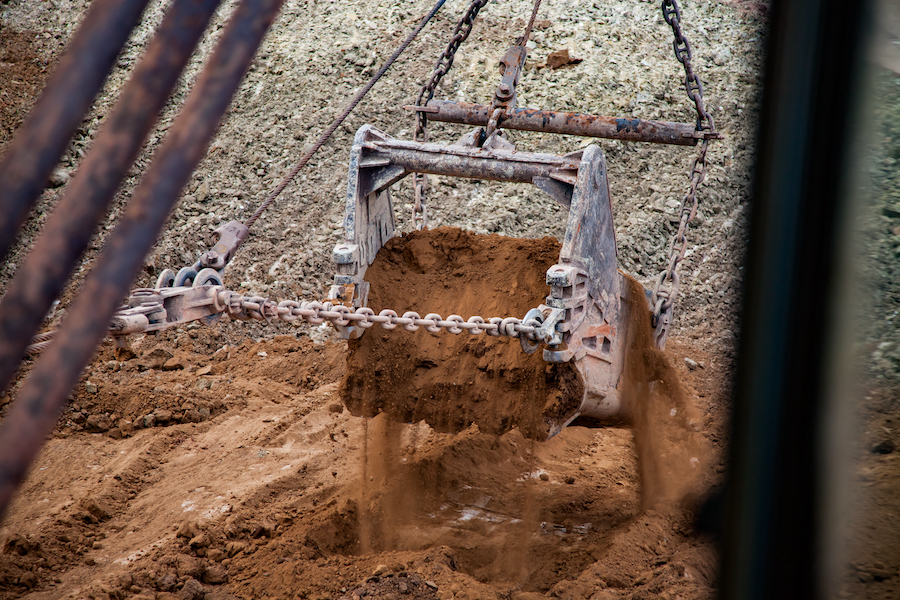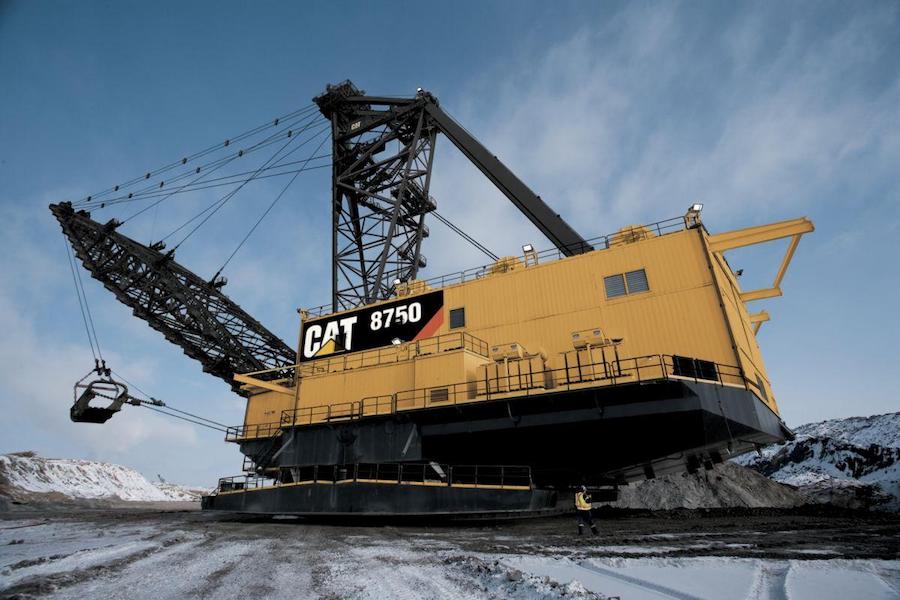
View the complete article here.
Some building projects take years to complete. But a mining operation can be in service for decades. They require huge pieces of equipment that can remain onsite. Dragline excavators built for the mining industry are not only some of the biggest machines ever built – they are the most productive.
How Dragline Excavators are Used in Mining
Dragline excavators in mining are used to remove overburden – anything that’s in the way of getting to the real product. For example, removing soil and rock from the surface above the coal seam. This overburden is repurposed, in some cases set aside to refill the open pit when the resources are exhausted. Dragline excavators fall into two major categories:
Standard Lifting Crane – With a Winch
The first category of draglines is based on a standard lifting crane. Add a winch drum to a crawler crane and you’ve got yourself a dragline. This type of dragline excavator is built offsite and transported to the mine. They can be readily dismantled and reassembled. This dragline excavator is more often used in civil engineering – to build roads, ports, and bridges.
Built Onsite
For large mining operations a bigger, heavier dragline excavator is needed. This type of equipment must be built onsite. It would cost too much to transport. These huge dragline excavators are meant to stay in place – and in service – for decades. Onsite dragline excavators are typically used in coal and oil sands strip mining. They are also used for dredging canals and ponds.
How Draglines in Mining Work
In essence, a large bucket is cast out away from the dragline excavator machine and dragged back, scooping up material as it moves. It is meant to pick up this material quickly and dump it a short distance away. It can do this far more quickly than a standard excavator. The material can then be moved offsite.

Anatomy of a Dragline
A dragline excavator consists of a boom, bucket, drag rope, hoist rope, and driving motors. Several ropes and chains are used to control the bucket. The bucket is attached with a truss-like structure called a dragline boom. The hoist rope is motor-driven and supports the hoist-coupler assembly. It keeps the bucket away from the boom. The drag rope moves the bucket horizontally back toward the machine.
Renowned Dragline Excavators
Back in the day, draglines were giant machines. Unfortunately, they proved to cost more to use and maintain and were dismantled. Today’s machines are comparatively smaller, but still mighty. One of the largest dragline excavators available today is the P&H 9020XPC, manufactured by Komatsu. But the history of the giant draglines is still of interest to many. Two great ones include:
Big Muskie
Bucryus-Erie built only one 4250-W dragline. Constructed in 1969, it took 200,000 hours to build at a cost of $25 million. Dubbed “Big Muskie,” the giant dragline was in service for over two decades. In 1991, Big Muskie was put out to pasture. A combination of higher electricity costs and lower coal demand made him too expensive to operate. The machine was also too expensive to dismantle. No one would buy it; it sat idle for eight years. Finally, the Environmental Protection Agency (EPA) forced the issue. New legislation required old machines to be moved off of defunct strip mining sites. Big Muskie was dismantled and sold for scrap. Well, almost all of him. The Big Muskie’s 240-ton bucket is proudly displayed in Miner’s Memorial Park in Ohio as a tribute to coal miners.
Bagger 288
Germany invented the Bagger 288, a low-power, high-efficiency bucket wheel excavator. In 1978 it was on record as the heaviest land vehicle in the world at 45,500 tons. Today it still holds the record as the largest land vehicle at 311 feet high and 705 feet long. It was first put to work at the Tagebau Hambach open pit coal mine, removing overburden. The Bagger 288 was then moved to the Tagebau Garzweiler coal mine in 2001. It took 70 workers and 15 million German marks to move the mammoth machine just 14 miles. The Bagger 288 can mine 240,000 tons of coal per day. Each of its 18 buckets holds 8.6 cubic yards. Its fate is yet unknown – Germany plans to phase out all coal-fired powered plants by 2038.
Evolving Technology
Human dragline excavator operators cause inconsistent product results – as much as a 15% variation. Companies like Mineware and CRCMining are working on automation systems to improve operator performance. Their goal is to provide instantaneous guidance on position, digging and dumping. The Pegasys Dragline Monitoring System by Mineware can improve productivity by up to 12% with real-time information and in-seat coaching for dragline operators.
Major Dragline Excavator Manufacturers
Caterpillar
Caterpillar has a few models of dragline excavators including the 8750. It has a boom length of 360-435 feet. Its bucket capacity is 100-152 cubic yards, and it has a working weight of about 13.1-15.9 million pounds.

Komatsu
Komatsu has a few models of dragline excavators that include some impressive technology. The P&H 9020C has a customizable boom length of 300-405 feet and a bucket capacity of 75 to 117 cubic yards. It comes standard with Komatsu’s Centurian electrical control system. This system has several integration features. The P&H 9020C has DC digital drives. This allows increased motor speed as compared to analog drives.
Liebherr
Liebherr’s HS 8300 mining dragline has a boom length up to 164 feet and a bucket capacity up to 15 cubic yards. (Although the company video for the product says it can be “equipped with buckets up to 17 cubic yards.”) This model has a 1675 horsepower hybrid drive which consumes less fuel.
Conclusion
Dragline excavators in mining are critical to removing overburden and material quickly and safely. The largest machines are built onsite. The upfront investment is huge, but high-production and low-cost over its decades-long service make it worth the expense. The dragline excavator has not changed much, but technology is improving its performance in the field. The perfect combination of brute strength and smarts.
View the complete article here.
What is the primary purpose of dragline excavators in mining?
Dragline excavators in mining are primarily used to remove overburden, such as soil and rock, to access valuable resources like coal seams, making them essential for efficient mining operations.
Can you provide information on renowned dragline excavators and their historical significance?













































